
How to Start Your Own Seedlings (Veg, Fruit, Flowers) and Save a Bundle
Starting your own plants from seeds is a great way to save money (quite a lot) and have the exact varieties you want, as local nurseries and big box stores often have a limited selection and few heirloom varieties of tomatoes, peppers, eggplants, squash, cucumbers, melons and other vegetables and flowers. So, you may think you have a black thumb and can't succeed, but, if you follow the simple directions below, I can assure you that you will have great results.
How much money can you save?
Ypou can save at least 90% of the cost. The math is simple. I'll use 100 plants as a figure, even though you may only want a dozen, because the math is simpler.
Buying the plants
In August 2025, most stores (Home Depot, Lowe's
Wal-Mart, etc.) are selling Bonnies plants for $3.68 (plus tax) , if
the tax rate is 7 or 85, that means $4 per 3" or 4" peat pot.
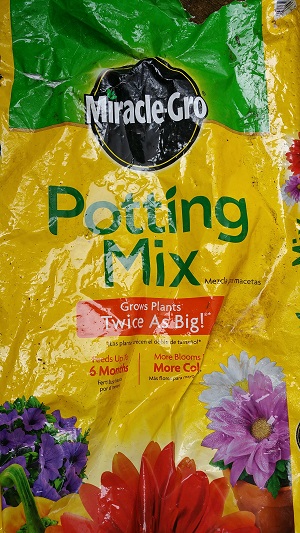
And to grow your own?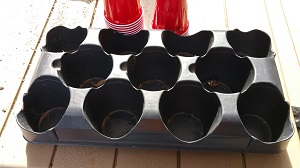
Here's what you will need:
- Plastic 16 ounce cups (commonly called "Solo cups") - about $10 for 240 at BJ's warehouse.
- Potting soil: Miracle-Grow - 40lb bag: $10 at Costco, BJ's or Sam's Club.
- Tray to hold the cups - free, just ask for the empties at Home Depot, Lowe's etc.
- Seeds - anywhere from $1.5 to $3 for a packet, for 100 plants, you'd need 2 or 3 packs, so let's say average total of $5.
That's it. To raise 100 plants, it would cost $10 for cups, $10 for potting soil, and $5 for seeds.
That is a total of $25, just 25 cents per plant. to get exactly what you want. Compared with $4 per plant at the store. Can you say "Obscene profit ,margins"?
Here's how to do it
Step 1 - Gather your supplies.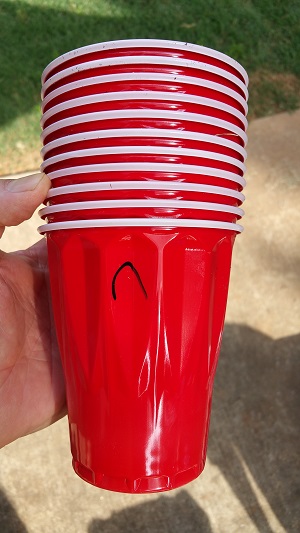
Here's what you will need and some common places to get them:
- 18 ounce size Solo cups (or any other sturdy large plastic cup at least 16 oz size)
- A tray to hold the cups to prevent them from falling over. The empty plant trays at Home Depot or Lowes work great. You could also use dish pans, or even cardboard boxes from Costco.
- Potting soil - the 50 Qt size bag of Miracle Gro potting soil will fill 100 cups. Why buy the soil? It is sterile, so there are no weed seeds in it. It is light and designed to have the best density for starting seeds. It has the nutrients the seeds need to get started. Is all of that true of the soil in your back yard?
- Seeds. Whatever you want to grow. This method works with almost anything. I've used this to raise hundreds of tomatoes, eggplants, cantaloupes, watermelons, peppers, lettuce, kale, Swiss chard, artichokes, etc.
- Tools: a scoop, hand trowel, etc. and a sharp knife or scissors and a sharpie pen or other permanent marker.
- A spray bottle filled with water
Step 2 - Label the cups.
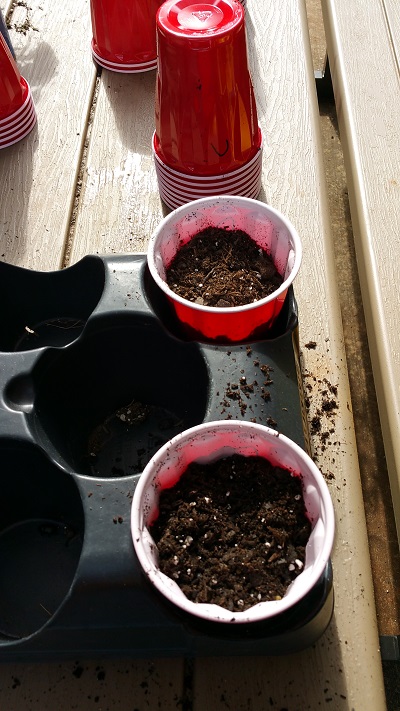
You can be as OCD or casual as you like. I just abbreviate, like C for cantaloupes, BK for Black Krim tomatoes, etc.
Step 3 - Fill the cups
Fill each cup 2/3 full with the potting soil. Do not tamp it down.
Step 4 - Add water
Add about 4 ounces of water to each cup. That will take sometime to fully obsorb, so although it shouldn't be soupy, it may have some free water. We add the water now to mpoisten it and it avoids uncovering the seeds if we did this after planting the seeds in the cups.
 Step 5 - Add the seeds to each cup
Step 5 - Add the seeds to each cup
Carefully place 3 seeds in each cup, spread apart (like at the points of a triangle). Why 3 seeds? Not every seed germinates! See the table farther down this page for typical germination rates, it varies from one plant to another, typically from 55% to 80%. SO, 3 seeds, pretty much ensures you will have at least one sprout. You can plant 4 or 5 seeds per cup if you have enough. And the converse is true, with larger seeds that have higher germination rates, like cantaloupes, you can put only 2 seeds in each cup.
Step 6 - Cover with more potting soil
Add more potting soil to cover the seeds. Typically, we
cover seeds with enough soil to make 4 times the diameter of the
seeds, but more most seeds, simply covering them with 1/2 inch of
potting soil is fin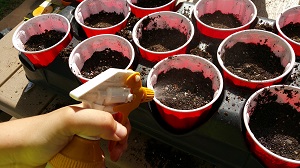 e.
e.
Step 7 - Spray more water into the cups
I set the spray onto a wide spray patter, so it won't wash away the seeds, then give each cup 10 squirts. This ensures that the soil above the seeds is moist, too.
Step 8 - Put in a warm place, sunny or not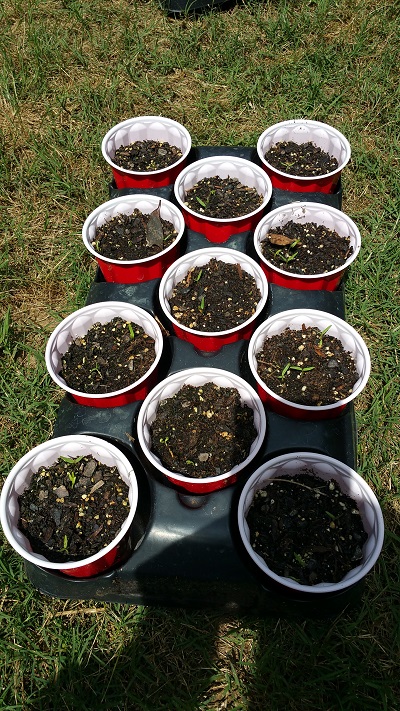
Most seeds have an optimal germination temperature. For most vegetable seeds it is between 75 F and 85 F. SO, a sunny location is fine, as long as you do not let the cups dry out. I check them every morning and every evening and use the spray bottle or gently pour in water with a cup, taking care not to uncover the seeds.
How long to wait? Most seeds germinate (sprout) within 7 to 10 days. Artichokes are a notable exception and can take 2 or 3 weeks!
| Vegetable
or Fruit Seed |
Germination
rates (%) |
Days to Germinate |
|---|---|---|
| Asparagus | 60 | 10 |
| Bean, Lima | 70 | 6 |
| Bean, Snap | 75 | 7 |
| Beets | 65 | 4 |
| Broccoli | 75 | 4 |
| Brussels Sprouts | 70 | 4 |
| Cabbage | 75 | 4 |
| Carrot | 55 | 6 |
| Cauliflower | 75 | 5 |
| Celeriac | 55 | 11 |
| Celery | 55 | 7 |
| Chicory | 65 | 6 |
| Chinese Cabbage | 75 | 4 |
| Cucumber | 80 | 3 |
| Eggplant | 60 | 6 |
| Endive | 70 | 6 |
| Kale | 75 | 4 |
| Kohlrabi | 75 | 4 |
| Leek | 60 | 7 |
| Lettuce | 80 | 3 |
| Muskmelon | 75 | 4 |
| New Zealand Spinach | 40 | 6 |
| Okra | 50 | 6 |
| Onion | 70 | 6 |
| Parsley | 60 | 13 |
| Parsnip | 60 | 14 |
| Pea | 80 | 6 |
| Pepper | 55 | 8 |
| Pumpkin | 75 | 4 |
| Radish | 75 | 4 |
| Rutabaga | 75 | 4 |
| Salsify | 75 | 6 |
| Spinach | 60 | 5 |
| Squash | 75 | 4 |
| Sweetcorn | 75 | 3 |
| Swiss Chard | 65 | 4 |
| Tomato | 75 | 6 |
| Turnip | 80 | 3 |
| Watermelon | 80 | 4 |
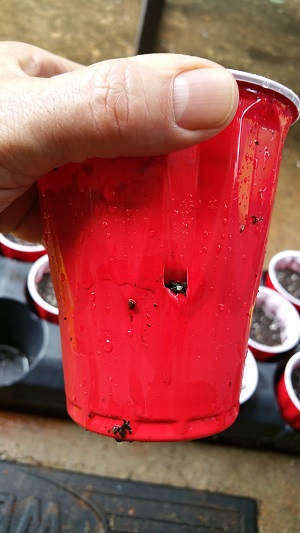 Step 9 - Punch a hole in the cup
Step 9 - Punch a hole in the cup
With a sharp knife or one side of a pair of scissors, I punch a hole about 1/4 inch to 1/2 inch in each cup, NOT in the bottom, but rather about 1/3 up from the bottom, on the side, as shown in the photo. Why? This keeps the seeds from becoming waterlogged by overwatering (or a heavy rain), yet retains enough water to allow it to be absorbed by the entire container. I've been doing this for many years and found this placement works best.
Step 10 - Watering, Sun and Thinning
Keep the the soil moist but not soggy. Don't let them dry out. If you see mold or fungus growing on the plants or soil, you are overwatering. Keep the plants in the sun. When they reach about 3 inches tall, thin them by using your scissors to carefully cut off the stems of all but one or 2 plants per cup. Then when they reach 4 or 5 inches tall, thin again to 1 plant per container. Always leave the strongest looking plants.
Planting out - Transplanting into the Garden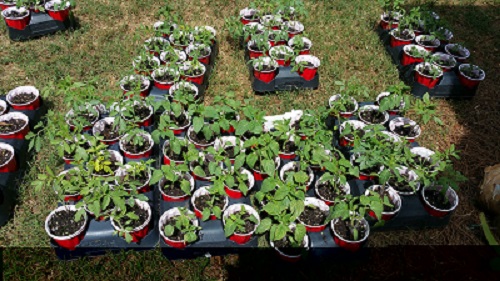
When the weather conditions in your garden are right and the plants are sturdy enough (usually 5 inches tall or higher), you are ready to plant them by simply gently sliding them out of the cups! That's it!
References:
-
STARTING PLANTS FROM SEEDS, North Carolina Cooperative Extension Service, NORTH CAROLINA STATE UNIVERSITY COLLEGE OF AGRICULTURE & LIFE SCIENCES, Erv Evans, Extension Associate, Horticultural Science, Frank A. Blazich, Professor, Horticultural Science, see Table 1. Germination information for selected plants: approximate time to seed before last frost, days for
germination, optimum temperature for germination, and light requirements - Handbook for Vegetable Growers. 1960. Knott, J.E. John Wiley and Sons, Inc.
- Seeds, The Yearbook of Agriculture. 1961. Stefferud, A., Editor. The United States Government Printing Office&URL=http%3A%2F%2Fextension.missouri.edu/sare/documents/KnottsHandbook2012.pdf"> Handbook for Vegetable Growers. 1960. Knott, J.E. John Wiley and Sons, Inc.
- Seeds, The Yearbook of Agriculture. 1961. Stefferud, A., Editor. The United States Government Printing Office
Looking for canning equipment and supplies?
Water bath canner with a jar rack
Pressure canners for gas, electric and induction stoves: Presto 23Qt or T-fal 22Qt
Canning scoop (this one is PERFECT)
Ball Blue book (most recent version)
Jars: 8oz canning jars for jams
Find Other types of farms:
Farm markets and roadside stands
Road trips and camping resources
Local Honey, apiaries, beekeepers
Consumer fraud and scams information
Home canning supplies at the best prices on the internet!
Maple Syrup Farms, sugarworks, maple syrup festivals
Environmental information and resources
Farms For Your Event for birthday parties, weddings, receptions, business meetings, retreats, etc.
Festivals - local fruit and vegetable festivals
Get the
most recent version of
the Ball Blue Book
With this Presto 23 quart pressure canner and pressure cooker, you can "can" everything, fruits, vegetables, jams, jellies, salsa, applesauce, pickles, even meats, soups, stews. Model 01781

You can make jams, jellies, can fruit, applesauce, salsa and pickles with water bath canners, like this Granite Ware 12-Piece Canner Kit, Jar Rack, Blancher, Colander and 5 piece Canning Tool Set

